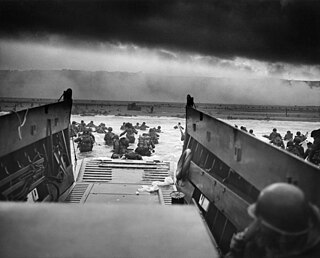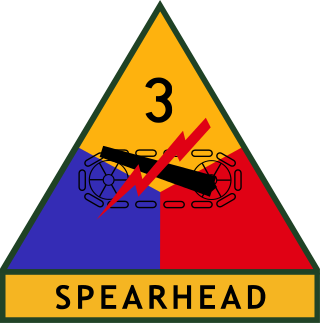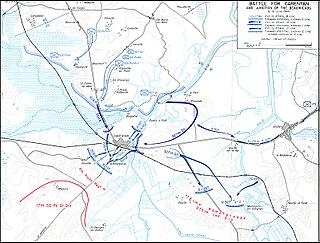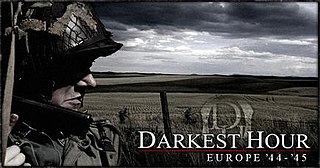
Mechanized infantry are infantry units equipped with armored personnel carriers (APCs) or infantry fighting vehicles (IFVs) for transport and combat.

The M4 Sherman, officially medium tank, M4, was the medium tank most widely used by the United States and Western Allies in World War II. The M4 Sherman proved to be reliable, relatively cheap to produce, and available in great numbers. It was also the basis of several other armored fighting vehicles including self-propelled artillery, tank destroyers, and armored recovery vehicles. Tens of thousands were distributed through the Lend-Lease program to the British Commonwealth, Soviet Union, and other Allied Nations. The tank was named by the British after the American Civil War General William Tecumseh Sherman.

The Normandy landings were the landing operations and associated airborne operations on 6 June 1944 of the Allied invasion of Normandy in Operation Overlord during the Second World War. Codenamed Operation Neptune and often referred to as D-Day, it is the largest seaborne invasion in history. The operation began the liberation of France, and the rest of Western Europe, and laid the foundations of the Allied victory on the Western Front.

The 3rd Armored Division was an armored division of the United States Army. Unofficially nicknamed the "Third Herd", the division was first activated in 1941 and was active in the European Theater of World War II. The division was stationed in West Germany for much of the Cold War and also participated in the Persian Gulf War. On 17 January 1992, still in Germany, the division ceased operations. In October 1992, it was formally inactivated as part of a general drawing down of U.S. military forces at the end of the Cold War.

Operation Bagration was the codename for the 1944 Soviet Byelorussian strategic offensive operation, a military campaign fought between 22 June and 19 August 1944 in Soviet Byelorussia in the Eastern Front of World War II, just over two weeks after the start of Operation Overlord in the west. It was during this operation that Nazi Germany was forced to fight simultaneously on two major fronts for the first time since the war began. The Soviet Union destroyed 28 of 34 divisions of Army Group Centre and completely shattered the German front line. The overall engagement is the largest defeat in German military history, with around 450,000 German casualties, while 300,000 other German soldiers were cut off in the Courland Pocket.

Operation Cobra was an offensive launched by the First United States Army under Lieutenant General Omar Bradley seven weeks after the D-Day landings, during the Normandy campaign of World War II. The intention was to take advantage of the distraction of the Germans by the British and Canadian attacks around Caen in Operation Goodwood, and thereby break through the German defenses that were penning in their forces, while the Germans were unbalanced. Once a corridor had been created, the First Army would then be able to advance into Brittany, rolling up the German flanks once free of the constraints of the bocage country. After a slow start, the offensive gathered momentum and German resistance collapsed as scattered remnants of broken units fought to escape to the Seine. Lacking the resources to cope with the situation, the German response was ineffectual mainly due to the effect of Operation Bluecoat and the entire Normandy front soon collapsed. Operation Cobra, together with concurrent offensives by the British Second Army and the Canadian First Army, was decisive in securing an Allied victory in the Normandy campaign.

The siege of Bastogne was an engagement in December 1944 between American and German forces at the Belgian town of Bastogne, as part of the larger Battle of the Bulge. The goal of the German offensive was the harbor at Antwerp. In order to reach it before the Allies could regroup and bring their superior air power to bear, German mechanized forces had to seize the roadways through eastern Belgium. Because all seven main roads in the densely wooded Ardennes highlands converged on Bastogne, just a few miles away from the border with neighboring Luxembourg, control of its crossroads was vital to the German attack.

The 2nd Panzer Division was an armoured division in the German Army, the Heer, during World War II.

The 9th Panzer Division was a panzer division of the German Army during World War II. It came into existence after 4th Light Division was reorganized in January 1940. The division was headquartered in Vienna, in the German military district Wehrkreis XVII.

The 9th SS Panzer Division "Hohenstaufen" was a Waffen-SS armoured division of Nazi Germany during World War II. It participated in battles on both the Eastern and Western Fronts. The division was activated in December 1942. Many of the men of the division were young German conscripts, with a cadre of NCOs and staff from the SS Division Leibstandarte and other Waffen SS divisions. Hohenstaufen took part in the relief of German forces in the Kamenets-Podolsky pocket, the Normandy battles, Operation Market Garden, the Ardennes Offensive and Operation Spring Awakening. The division surrendered to the United States Army on 8 May 1945, at Steyr.
The 3rd Panzer Army was a German armoured formation during World War II, formed from the 3rd Panzer Group on 1 January 1942.

The Battle of Carentan was an engagement in World War II between airborne forces of the United States Army and the German Wehrmacht during the Battle of Normandy. The battle took place from 10 to 14 June 1944, on the approaches to and within the town of Carentan, France.

Operation Overlord was the codename for the Battle of Normandy, the Allied operation that launched the successful liberation of German-occupied Western Europe during World War II. The operation was launched on 6 June 1944 (D-Day) with the Normandy landings. A 1,200-plane airborne assault preceded an amphibious assault involving more than 5,000 vessels. Nearly 160,000 troops crossed the English Channel on 6 June, and more than two million Allied troops were in France by the end of August.
The Panzer Grenadier series of board wargames is Avalanche Press's series of World War II and The Korean War tactical land combat. The first game in the series was released in 2000.

Darkest Hour: Europe '44-'45 is a free modification developed by Darklight Games, and The Darkest Hour Team for Tripwire Interactive's multiplayer first-person shooter video game Red Orchestra: Ostfront 41-45, It is based on the Western Front during World War II between 1944 and 1945, depicting the conflict between Allied and German forces. Several large-scale operations are covered, including the invasion of Normandy, Battle of the Bulge, Operation Market Garden, and Battle of the Hürtgen Forest.
I Ain't Been Shot Mum! is a World War II tabletop skirmish miniatures wargame produced by Too Fat Lardies.

A light tank is a tank variant initially designed for rapid movements in and out of combat, to outmaneuver heavier tanks. It is smaller with thinner armor and a less powerful main gun, tailored for better tactical mobility and ease of transport and logistics. They are primarily employed in the screening, armored reconnaissance, skirmishing, artillery observation, and supplementing landing operations in a fire support role of expeditionary forces where larger, heavier tanks are unavailable or have difficulties operating safely or efficiently.

Al Murray's Road to Berlin is a British documentary television series about World War II, presented by Al Murray. The ten-episode series was produced for the Discovery Channel, and first broadcast in 2004. During the series, Murray travels across the Western Front in a restored Willys MB Jeep, covering the timeline from the Invasion of Normandy to the fall of Berlin, interviewing survivors and showcasing some of the equipment used.

Combat Mission is a series of computer wargames simulating tactical battles. The series has progressed through two distinct game engines. The original game engine, referred to as 'CMx1' by the developer, Battlefront.com, powered a trio of games set in the Second World War. Combat Mission: Shock Force was released in July 2007 as the debut of the 'CMx2' game engine. The Combat Mission games are a mixture of turn-based gameplay and simultaneous real-time execution. The game environment is fully three-dimensional, with a "Wego" style of play wherein each player enters their orders into the computer simultaneously during pauses in the action, and then are powerless to intervene during the action phase. More familiar turn-based games use an "I-go/You-go" system of play.

Combat Mission: Battle for Normandy (CMBN) is a video game in the Combat Mission series. It is a simulation of infantry combat at the platoon and company level, during World War II, set during the battle of Normandy. The base game models some of the typical American and German army forces in use at that time. Expansion modules are also available, that provide additional nationalities, locations, and time frames.

















